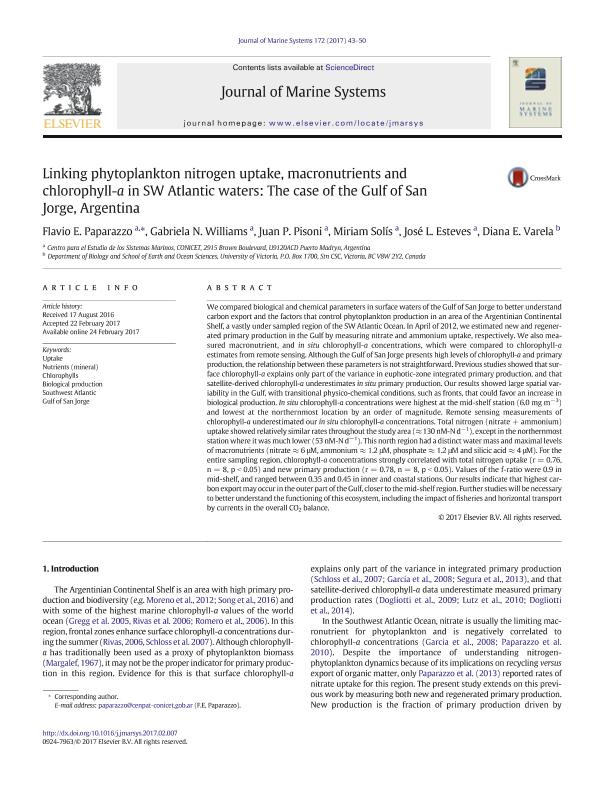Artículo
Linking phytoplankton nitrogen uptake, macronutrients and chlorophyll-a in SW Atlantic waters: The case of the Gulf of San Jorge, Argentina
Paparazzo, Flavio Emiliano ; Williams, Gabriela Noemí
; Williams, Gabriela Noemí ; Pisoni, Juan Pablo
; Pisoni, Juan Pablo ; Solis, Miriam Edith
; Solis, Miriam Edith ; Esteves, Jose Luis
; Esteves, Jose Luis ; Varela, Diana E.
; Varela, Diana E.
 ; Williams, Gabriela Noemí
; Williams, Gabriela Noemí ; Pisoni, Juan Pablo
; Pisoni, Juan Pablo ; Solis, Miriam Edith
; Solis, Miriam Edith ; Esteves, Jose Luis
; Esteves, Jose Luis ; Varela, Diana E.
; Varela, Diana E.
Fecha de publicación:
12/2016
Editorial:
Elsevier Science
Revista:
Journal Of Marine Systems
ISSN:
0924-7963
Idioma:
Inglés
Tipo de recurso:
Artículo publicado
Clasificación temática:
Resumen
We compared biological and chemical parameters in surface waters of the Gulf of San Jorge to better understand carbon export and the factors that control phytoplankton production in an area of the Argentinian Continental Shelf, a vastly under sampled region of the SW Atlantic Ocean. In April of 2012, we estimated new and regenerated primary production in the Gulf by measuring nitrate and ammonium uptake, respectively. We also measured macronutrient, and in situ chlorophyll-a concentrations, which were compared to chlorophyll-a estimates from remote sensing. Although the Gulf of San Jorge presents high levels of chlorophyll-a and primary production, the relationship between these parameters is not straightforward. Previous studies showed that surface chlorophyll-a explains only part of the variance in euphotic-zone integrated primary production, and that satellite-derived chlorophyll-a underestimates in situ primary production. Our results showed large spatial variability in the Gulf, with transitional physico-chemical conditions, such as fronts, that could favor an increase in biological production. In situ chlorophyll-a concentrations were highest at the mid-shelf station (6.0 mg m−3 ) and lowest at the northernmost location by an order of magnitude. Remote sensing measurements of chlorophyll-a underestimated our in situ chlorophyll-a concentrations. Total nitrogen (nitrate + ammonium) uptake showed relatively similar rates throughout the study area (≈130 nM-N d−1 ), except in the northernmost station where it was much lower (53 nM-N d−1 ). This north region had a distinct water mass and maximal levels of macronutrients (nitrate ≈ 6 μM, ammonium ≈ 1.2 μM, phosphate ≈ 1.2 μM and silicic acid ≈ 4 μM). For the entire sampling region, chlorophyll-a concentrations strongly correlated with total nitrogen uptake (r = 0.76, n = 8, p b 0.05) and new primary production (r = 0.78, n = 8, p b 0.05). Values of the f-ratio were 0.9 in mid-shelf, and ranged between 0.35 and 0.45 in inner and coastal stations. Our results indicate that highest carbon export may occur in the outer part of the Gulf, closer to the mid-shelf region. Further studies will be necessary to better understand the functioning of this ecosystem, including the impact of fisheries and horizontal transport by currents in the overall CO2 balance.
Archivos asociados
Licencia
Identificadores
Colecciones
Articulos(CESIMAR)
Articulos de CENTRO PARA EL ESTUDIO DE SISTEMAS MARINOS
Articulos de CENTRO PARA EL ESTUDIO DE SISTEMAS MARINOS
Citación
Paparazzo, Flavio Emiliano; Williams, Gabriela Noemí; Pisoni, Juan Pablo; Solis, Miriam Edith; Esteves, Jose Luis; et al.; Linking phytoplankton nitrogen uptake, macronutrients and chlorophyll-a in SW Atlantic waters: The case of the Gulf of San Jorge, Argentina; Elsevier Science; Journal Of Marine Systems; 172; 12-2016; 43-50
Compartir
Altmétricas



